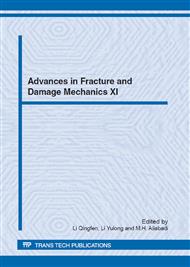p.393
p.397
p.401
p.405
p.409
p.413
p.417
p.421
p.425
Effect of Characteristic Parameters of Exponential Cohesive Zone Model on Mode I Fracture of Laminated Composites
Abstract:
Delamination is a particularly dangerous damage mode of high performance laminated composites. In order to describe the composites ductile cracking and its progressive evolution accurately, the adjusted exponential cohesive zone model (CZM) is adopted, which correlates the tensile traction with the corresponding interfacial separation along the fracturing interfacial zone. At first the adjusted exponential CZM is used to simulate the mode I delamination of the standard double cantilever beam (DCB). The simulated results are in good agreement with the corrected beam theory and the corresponding experimental results. Then in order to research how the interfacial properties influence the mode I fracture, the interfacial strength and the critical energy release rate are studied. The main results are obtained as follows. The interfacial strength plays a crucial role in the laminated composites delamination onset, and it affects the peak load significantly if there is not a pre-crack. Once the delamination propagation begins to occur in the laminated composites, the responses of the load-displacement plots are relatively insensitive to the interfacial strength, and only the critical energy release rate is of critical importance. Furthermore, the peak load increases with the increase of the critical energy release rate and interfacial strength.
Info:
Periodical:
Pages:
409-412
Citation:
Online since:
November 2012
Authors:
Price:
Сopyright:
© 2013 Trans Tech Publications Ltd. All Rights Reserved
Share:
Citation:


